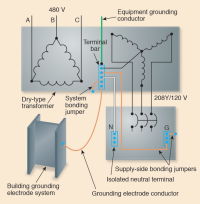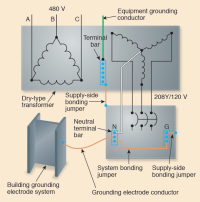-
Welcome to The Building Code Forum
Your premier resource for building code knowledge.
This forum remains free to the public thanks to the generous support of our Sawhorse Members and Corporate Sponsors. Their contributions help keep this community thriving and accessible.
Want enhanced access to expert discussions and exclusive features? Learn more about the benefits here.
Ready to upgrade? Log in and upgrade now.
You are using an out of date browser. It may not display this or other websites correctly.
You should upgrade or use an alternative browser.
You should upgrade or use an alternative browser.
Two Ways A Transformer Can Be Grounded & Bonded
- Thread starter jar546
- Start date
wwhitney
REGISTERED
Those are two ways to ground the secondary side of a transformer as a Separately Derived System (SDS).
When the primary side system is grounded, another option for grounding the secondary side as a non-SDS is by connecting the primary side grounded conductor to one of the secondary conductors. Then no Grounding Electrode Conductor is required, there is no System Bonding Jumper, and the Supply Side Bonding Jumper is just called an EGC.
Just FYI.
Cheers, Wayne
When the primary side system is grounded, another option for grounding the secondary side as a non-SDS is by connecting the primary side grounded conductor to one of the secondary conductors. Then no Grounding Electrode Conductor is required, there is no System Bonding Jumper, and the Supply Side Bonding Jumper is just called an EGC.
Just FYI.
Cheers, Wayne
jar546
CBO
I agree. Which method do you see used?Those are two ways to ground the secondary side of a transformer as a Separately Derived System (SDS).
When the primary side system is grounded, another option for grounding the secondary side as a non-SDS is by connecting the primary side grounded conductor to one of the secondary conductors. Then no Grounding Electrode Conductor is required, there is no System Bonding Jumper, and the Supply Side Bonding Jumper is just called an EGC.
Just FYI.
Cheers, Wayne
chris kennedy
ADMIN
I use option 1.
jar546
CBO
That is because Option 1 is the far superior method in most instances.I use option 1.
wwhitney
REGISTERED
The only difference is the location of the SBJ and where the GEC terminates. Why is it better to have those at the transformer?That is because Option 1 is the far superior method in most instances.
Cheers, Wayne
jar546
CBO
Two reason:The only difference is the location of the SBJ and where the GEC terminates. Why is it better to have those at the transformer?
Cheers, Wayne
1) It is the most common so you have consistency with inspections (not a big deal)
2) The facility can treat all panelboards as sub-feeds, since the neutral and EGC are separated. Sometimes you can't see the transformer or know that a panelboard is fed by a transformer, so it again, creates consistency. Option two may seem confusing to maintenance staff that does not know better.
3) I prefer it. I'll pass whatever method a contractor uses as long as it is compliant, regardless of my personal preferences.


